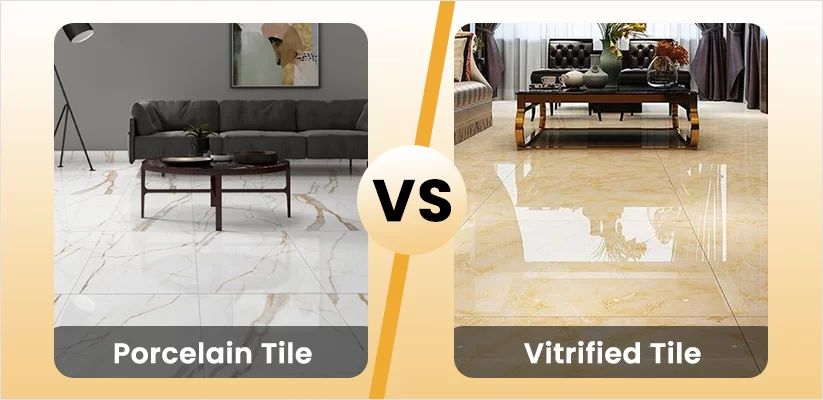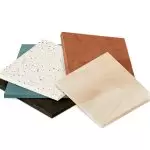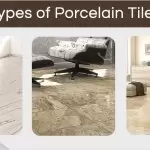Are you planning a home renovation and unsure whether to go for porcelain tiles or vitrified tiles?
Post your Requirement
We understand the dilemma! Let’s delve deeper into the characteristics and benefits of each option to help you make an informed decision. From durability and aesthetics to cost and maintenance, we’ll guide you in selecting the perfect tile for your project.
Porcelain Tiles:
-
Composition:
Porcelain tiles are made from a mixture of fine clays and minerals, which are compressed and fired at high temperatures. They have a low water absorption rate, typically less than 0.5%, making them highly resistant to water and moisture.
-
Strength and Durability:
Porcelain tiles are known for their exceptional strength and durability. They can withstand heavy foot traffic and are highly resistant to scratches, stains, and impact. This makes them suitable for high-traffic areas such as commercial spaces, hallways, and kitchens.
-
Design Options:
Porcelain tiles come in a wide range of designs, patterns, and finishes. They can mimic natural materials like marble, wood, or stone, offering a versatile and aesthetic appeal. From matte to polished finishes, porcelain tiles cater to various design preferences.
Vitrified Tiles:
-
Composition:
Vitrified tiles are made by combining clay with silica, quartz, and feldspar. This mixture is subjected to high-pressure molding and fired at a higher temperature than porcelain tiles. The vitrification process makes the tile dense and less porous.
-
Stain and Scratch Resistance:
Vitrified tiles have a low porosity level, making them highly resistant to stains and water absorption. They are also scratch-resistant, making them suitable for areas prone to wear and tear, such as commercial spaces and homes with pets or children.
-
Uniformity and Strength:
Vitrified tiles have a consistent color and pattern throughout the tile, thanks to their uniform composition. They exhibit high strength and can withstand heavy loads, making them suitable for both residential and commercial applications.
Difference Between Porcelain Tiles & Vitrified Tiles:
Similar to efficiently carved architectural designs, porcelain tiles are mightily formed from fine clay, thereafter it is burned at extremely high temperatures to create a robust, durable, and weather-resistant structure. Their sophisticated patterns and vivid colors emanate a feeling of modern aesthetics and elegance, and their resistance to stains, moisture, and dampness makes them an ideal option for high-traffic spaces.
Whereas, vitrified tiles, which are like polished gems of creativity, are created by converting silica and clay through extreme heat, assuring a faultless and sophisticated surface that shines like glass. These modern-day tiles, which are already popular for durability, robustness, and ease of maintenance, have a modern charm that adds a touch of style, aesthetics, and functionality to create contemporary and aesthetically pleasing spaces. Below, you can see multiple differences between them;
-
Water Absorption:
Porcelain tiles have lower water absorption than vitrified tiles, making them more suitable for areas exposed to water, such as bathrooms and kitchens.
-
Finishes:
Porcelain tiles offer a wider range of finishes, including matte, polished, textured, and patterned options. Vitrified tiles generally come with a glossy finish.
-
Installation:
Porcelain tiles are typically thicker and denser than vitrified tiles, requiring specialized tools and expertise for installation. Vitrified tiles are relatively easier to install.
-
Pricing:
Vitrified tiles are generally more affordable than porcelain tiles. However, the cost can vary depending on factors such as design, brand, and quality.
How Would you Choose Porcelain Tiles vs Vitrified Tiles?
Choosing between porcelain tiles and vitrified tiles depends on various factors that need to be considered. Here’s a step-by-step guide to help you make the right choice:
-
Assess your needs:
Determine the area of application and the purpose of the tiles. Consider factors such as foot traffic, exposure to water or moisture, and the overall design aesthetic you want to achieve.
-
Durability and strength:
Both porcelain tiles and vitrified tiles are known for their durability. If you require tiles for high-traffic areas or spaces prone to wear and tear, such as commercial spaces or hallways, porcelain tiles may be a better choice due to their higher strength and scratch resistance.
-
Water resistance:
If you need tiles for areas exposed to water, like bathrooms or kitchens, porcelain tiles are generally recommended as they have lower water absorption rates compared to vitrified tiles. However, vitrified tiles with low porosity can also work well in these areas.
-
Design options:
Consider the design aesthetic you want to achieve. Porcelain tiles offer a wider range of design options, including various finishes (matte, polished, textured) and patterns that can mimic natural materials. Vitrified tiles often come with a glossy finish, which may be preferred in certain design styles.
-
Budget considerations:
Evaluate your budget for the tile installation. In general, vitrified tiles tend to be more affordable than porcelain tiles. However, keep in mind that the price can vary depending on factors like brand, design, and quality.
-
Maintenance:
Consider the level of maintenance you are willing to undertake. Porcelain tiles are generally easier to clean and require minimal maintenance. Vitrified tiles, while also relatively easy to maintain, may require more attention to keep the glossy finish intact.
-
Manufacturing:
To create dense, long-lasting tiles, refined clay is fired at high temperatures during the manufacturing process. Whereas, created by heating silica and clay together to a high temperature, which leaves a surface that is glass-like and non-porous.
-
Usage:
Since their resistance to stains. moisture and dampness, they are perfect for applications both indoors and outdoors, whereas, vitrified tiles are ideal for diverse interior applications use, providing remarkable robustness and durability with little upkeep or maintenance.
-
Porosity:
Porcelain tiles are preeminent owing to their low porosity, they are appropriate for wet environments like bathrooms and kitchens. Whereas, vitrified tiles are ideal for diverse spaces such as living rooms and hallways where there is a lot of foot circulation because of their nearly non-porous nature.
-
Texture:
Porcelain tiles with diverse texture interpretations of porcelain tiles can easily adjust a comprehensive range of design preferences, from textured surfaces for enhanced grip to smooth finishes for a streamlined appearance. Whereas, vitrified tiles with matte surfaces for a modern and classic look can add on various factors.
-
Seek professional advice:
Consult with tile experts or professionals who can provide guidance based on your specific requirements and the characteristics of your space. They can offer insights and recommendations tailored to your needs.
Conclusion
Choosing between porcelain tiles and vitrified tiles depends on your specific requirements, preferences, and budget. Porcelain tiles offer a vast range of design options, superior durability, and water resistance. On the other hand, vitrified tiles provide excellent stain resistance, uniformity, and affordability. Assess your project needs, consider the location and foot traffic, and explore the available design options to determine the best choice for your flooring project. Remember to consult with professionals to ensure proper installation and maintenance for long-lasting, beautiful floors.























Post A Comment